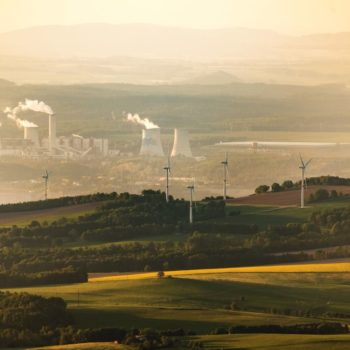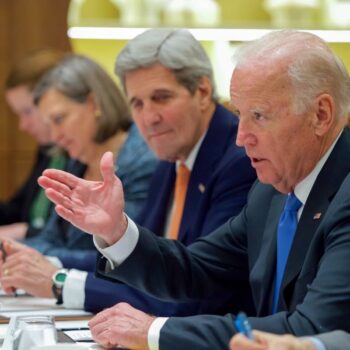This article is part of our series on coal phase out and the G7 in 2021. You can find a full list of articles, along with the backstory of our analysis of G7 coal trends since 2015, here.
For the first time in six editions, E3G’s annual review of G7 progress finds that performance has improved in all countries. The underlying data trends and direction of government policy actions are positive, providing a platform for both further acceleration of national coal phase out efforts and G7 cooperation.
The interactive graphic below provides an overview showing the year-on-year changes in performance of the G7 countries. Select a year from the drop-down menu to see the evolution of country actions and their position relative to their peers. The 2021 scorecard includes commentary explaining notable changes to our assessment or highlights of country performance. Hover over the scores with a bold outline to see this additional information.
Figure A: 2021 E3G G7 coal scorecard. View the graphic on Tableau here.
2021 Progress
The top of the G7 scorecard sees Canada, UK and France continue in the leading positions. Each has made further progress since our last report in 2019 on domestic policy and restricting coal finance.
Domestic policy:
- In Canada, Alberta’s coal phase out will be completed in 2023, seven years ahead of schedule.
- The UK has moved its coal phase out end date to 2024 but is still yet to legislate. As just one coal power plant will remain operational beyond 2021 there is a possibility that changes to the capacity market might suffice.
- France legislated for its 2022 coal phase out in November 2019, putting its last four power plants on a pathway to closure.
Coal Finance:
- In Canada, private sector financial actors are beginning to restrict coal finance, including Caisse de dépôt et placement du Québec and Desjardins Group joining the Powering Past Coal Alliance.
- In 2020, the UK restricted all public finance for coal from export credits and development assistance. It subsequently extended this approach to all fossil fuels in early 2021.
- France has been the driving force behind the creation of the Export Finance for Future coalition (E3F). E3F includes the aim of ending trade and export support directed to unabated coal power.
Germany and the USA both move up the scorecard ranking, each making improvements in multiple categories.
In the context of G7 international influence, it is notable that Germany is incorporating coal phase out and Just Transition into its climate diplomacy and bilateral relations, including with China. Germany’s international leadership impact will further increase as it revises its coal phase out date from 2038 towards 2030.
Across the Atlantic, President Biden’s election resulted in an immediate improvement to US scorecard performance as the previous pro-coal rhetoric and policy vandalism of the Trump era fell away. At home, the Biden Administration has set out its intention to decarbonise the US power sector by 2035, taking action to provide Just Transition finance for workers and coal communities.
Internationally, the US had a busy April 2021, announcing restrictions on overseas fossil fuel financing, including coal finance through the US’s export credit agencies. And ahead of President Biden’s Leaders’ summit, Secretary of State Blinken stated that the US will use its diplomatic network to challenge countries that are still pursuing new coal investments.
This statement of intent is welcomed, but to secure influence the US will need to connect and communicate its domestic progress and cooperate with G7 peers and other progressive governments. It is not enough for the new administration to be ‘Not Trump’. The world has moved on over the past five years and action on coal is now a collective effort.
Italy saw some further improvements in its coal transition, but has slipped down the rankings as Germany and the USA took positive steps:
- Major utility company Enel is accelerating its coal phase out plans, closing plants in Chile and Spain as well as Italy.
- Italy has not yet confirmed an end to export credit finance for coal and is not yet a member of the E3F coalition. It should join with its G7 peers in announcing an end to public finance for coal.
Finally, Japan remains in last place in the scorecard rankings, as it made improvements in four categories but started from a very low baseline of performance. Notable highlights include:
- The last two coal plants in Japan’s development pipeline were cancelled in April 2021. However, 6GW of capacity remains under construction.
- In 2020, the Japanese government announced that it would close most the country’s less efficient coal plants by 2030. These initial closures will need to be extended to put Japan on a pathway to 46-50% emissions reductions by 2030.
- In 2020, Japan announced a presumption against provision of international coal finance, but with notable exceptions related to high-efficiency projects and recipient country conditions, and uncertainty regarding projects under consideration. Japan should join with South Korea and other G7 members to end all public finance for coal, and commit to working together through the OECD Export Credit review.
- Despite Japan’s steps towards ending coal finance, it has yet to clearly articulate an end to support to coal in its bilateral relations.
As in previous years, the category of private finance support to international coal projects remained the weakest across all countries, despite positive progress being made. This presents a prime target for collective G7 regulatory action in 2022.
Jump to another article in this series:
- Charting the course away from coal: the G7’s leadership opportunity
- Strong currents: G7 coal transition data trends
- Surfing the waves: G7 progress towards coal phaseout
- Picking up the pace: Germany’s coal exit is getting closer to 2030
- Anchors aweigh: USA rejoins the coal transition mainstream
- Time and tide wait for no one: Japan’s coal progress


